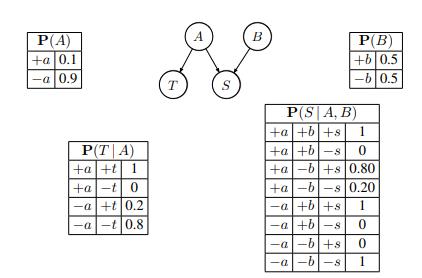Suppose that a patient can have a symptom (S) that can be caused by two different diseases
Question:
Suppose that a patient can have a symptom (S) that can be caused by two different diseases (A and B). Disease A is much rarer, but there is a test T that tests for the presence of A. The Bayes net and corresponding conditional probability tables for this situation are shown in Figure S13.30.
a. Compute the entry P(−a, −t, +b, +s) from the joint distribution.
b. What is the probability that a patient has disease A given that they have disease B?
c. What is the probability that a patient has disease A given that they have symptom S, disease B, and test T returns positive?
d. What is the probability that a patient has disease A given that they have symptom S and test T returns positive?
e. Suppose that both diseases A and B become more likely as a person ages. Add any necessary variables and/or arcs to the Bayes net to represent this change. For any variables you add, briefly (one sentence or less) state what they represent. Also, state one independence or conditional independence assertion that is removed due to your changes.
f. Based only on the structure of the (new) Bayes net given in Figure S13.31, decide whether the following conditional independence assertions are guaranteed to be true, guaranteed to be false, or cannot be determined by the structure alone.
(i) V ⊥⊥ W
(ii) V ⊥⊥ W | U
(iii) V ⊥⊥ W | U, Y
(iv) V ⊥⊥ Z | U, X
(v) X ⊥⊥ Z | W
Figure S13.30

Step by Step Answer:

Artificial Intelligence A Modern Approach
ISBN: 9780134610993
4th Edition
Authors: Stuart Russell, Peter Norvig





